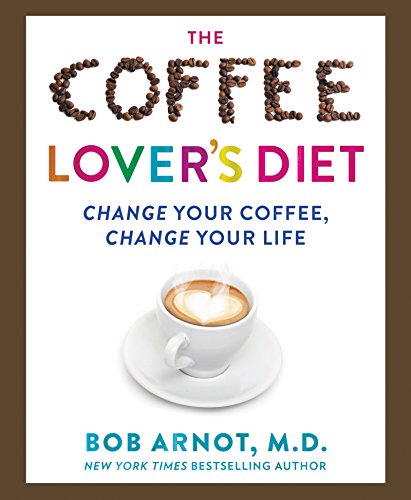You have no items in your shopping cart.
The Coffee Lover’s Diet – 10 Ideas from the Book

I recently read the book The Coffee Lover’s Diet by Bob Arnot M.D. I really enjoyed the first part of the book as it broke down the current state of information regarding the health benefits of coffee. The second part of the book covered coffee brewing and roasting. And the final part covered dieting and recipes. This overview will focus mostly on the first part.

Here are the 10 things I found most interesting in the Coffee Lover’s Diet.
#1 Reduced risk of death
Dr. Arnot mentions a 2012 National Institutes of Health study showing:
Coffee drinkers were less likely to die from heart disease, respiratory disease, stroke, injuries and accidents, diabetes, and infections.
And this benefit was for both regular and decaffeinated coffee drinkers. He then goes on to cite a 2015 study by the New England Journal of Medicine that used 400,000 participants which found that significant coffee consumption reduced the risk of death from all causes by 15% in women and by 10% in men.
But how does coffee provide these benefits? Read on.
#2 Coffee Has Polyphenols
Polyphenols are the anti-inflammatory compounds found in fruits and vegetables. Blueberries and cherries are especially high. They are also in coffee, including decaf coffee. Some coffees contain more polyphenols than others. The author refers to these coffees as high-phenol coffees.
Coffees with high-phenol counts are grown at higher altitudes and can be found with good scores on Coffee Review.
Higher altitude coffees also tend to have less caffeine. Caffeine protects the coffee plant from insects. The higher the coffee is grown, the fewer insects there are, because the air is thinner. So the plants produce a little less caffeine.
#3 Coffee is the #1 source of antioxidants in the US Diet
The Coffee Lover’s Diet has a chart by Joe Vinson Ph.D. showing the most common foods Americans eat with antioxidants and coffee is the leader by far. Tea is a distant second.
#4 Coffee Improves Physical Performance
Dr. Arnot states three ways that coffee can help the athlete. Improving speed/power during exercise, assists with fat burning, and by helping fight free radical oxidation.
#5 Cholesterol’s Role in Coffee is Complicated
On one hand, the chlorogenic acids in coffee can reduce the oxidation of LDL cholesterol. On the other hand, unfiltered coffee contains cholesterol in its fat molecules. But that might not be a bad thing, since one of those fats is cafestol, which has powerful anti-inflammatory benefits.
If cholesterol in coffee is a concern, use a filter or limit the amount of unfiltered coffee you consume. The book doesn’t say specifically, but I assume they mean a paper filter.
#6 Green Coffee Extract for Reducing Blood Pressure
The role of coffee in blood pressure continues to be debated. Dr. Arnot briefly mentions how green coffee extract can reduce blood pressure, due to its very high levels of chlorogenic acid. And if caffeine is a concern, green coffee extracts are also sold in decaf form.
#7 Meet Melanoidin
Melanoidin is an antioxidant in coffee that decreases the absorption of some fats. Dr. Arnot explains that fat peroxidation is a process that can lead to damaged cell membranes and increase the risk of coronary artery disease. Good to know that melanoidin can help.
Time your coffee after meals for this benefit.
#8 “Defy Diabetes”
In a section titled “Defy Diabetes”, Dr. Arnot makes an argument that the chlorogenic acids in high-phenol coffees help to lower blood sugar and increase insulin sensitivity.
#9 Neuroprotective
You’ve probably read news stories about the benefits coffee has with conditions such as Alzheimer’s and Parkinson’s disease. A theory that explains why this might work is that caffeine blocks the receptors of nerve cells that would have been targeted by clusters of beta-amyloid molecules.
#10 Avoid the Dark Roasts
Dr Arnot states:
Very dark roasts destroy coffee’s most beneficial components and lead most people to pad their diets and waistlines with cream and sugar.
Also roasting coffees dark at high temperatures can destroy the polyphenols and can even generate acrylamide, which is a carcinogenic chemical. There is a chart on page 108 in the hardcover edition that shows the complete collapse of chlorogenic acid levels as the roasting temperature is increased.
In tests, the author measured 30% loss in chlorogenic acids in light roasts, 50% in medium roasts, and almost 90% in dark roasts. And while the good chlorogenic acid levels are falling during the roast, the bad acrylamide levels are rising.
What the Book Missed
There is no question that the book was strongly biased towards the benefits of coffee, which seem to be mostly about high levels of anti-oxidants that one could get just as easily from blueberries and other “super foods”. The problem that was glossed over was sleep.
Coffee or caffeine in general can greatly reduce the quality of your sleep. And when sleep quality drops, lots of other health issues can develop. Check out the book Why We Sleep: Unlocking the Power of Sleep and Dreams by Matthew Walker, Ph.D. for more information on sleep. The role of caffeine is covered.
A true conversation on the health of a coffee drinker would balance the benefits (polyphenols) while at the same time addressing the role caffeine has on the different stages of sleep.
Last Words
There are a lot more ideas in the Coffee Lover’s Diet than the ones I posted. If you want to dive deeper into those ideas, check out the book and all its references. The second half of the book includes some coffee brewing tutorials and some high anti-oxidant recipes.

